


Background info > Articles > Critical overview
Written by Philippa Sidle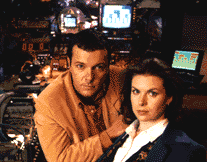 Crime Traveller was shown in eight 50-minute episodes from March to April 1997, just after eight o'clock on Saturday evening on BBC1. Created by veteran scriptwriter Anthony Horowitz, its scheduling in this prime-time slot - and the casting of a well-known soap opera actor in one of the lead roles - suggests that it was conceived as a popular, family-oriented show.
Crime Traveller was shown in eight 50-minute episodes from March to April 1997, just after eight o'clock on Saturday evening on BBC1. Created by veteran scriptwriter Anthony Horowitz, its scheduling in this prime-time slot - and the casting of a well-known soap opera actor in one of the lead roles - suggests that it was conceived as a popular, family-oriented show.
Mainstream critical reaction to the first episodes was tinged with incredulity, rejecting the fantastical elements of the scenario, and serious sci-fi followers will probably dislike its lightweight, populist approach. But although it generates a long list of questions beginning "Why is it that?", Crime Traveller has ingenious plots, enjoyable characterisation and an unforced, pleasant 'retro' feel. It seems to echo the fantasy cop shows of the sixties and seventies, before crime drama became grim and gritty and science fiction went all grown up.
Background
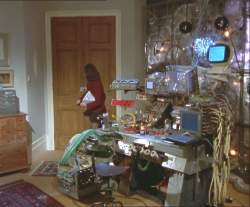
Holly Turner is a young, serious-minded quantum physicist who works as a science officer in a London police department. But Holly is no ordinary police department science officer - she has a secret. Hidden in her top-floor mansion flat is a time machine, built by her boffin father. Since her father's untimely death Holly has continued to work on the machine to complete and perfect it, battling against a constant lack of funds for the expensive components and keeping its existence a deadly secret.
However, she chooses to reveal this secret to possibly the most unsuitable person she could have found - Jeff Slade, a laid-back police detective whose relaxed attitude is always getting him into trouble with his superiors. In the first episode Holly uses the time machine to help Slade when he is in danger of losing his job over a bungled case, then takes him into her confidence over how she did it. Slade realises immediately that the time machine is the perfect crime-solving device, and from then on constantly manipulates Holly into letting him use it for this purpose.
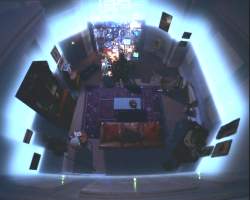
The machine has limitations. A Heath Robinson contraption which looks like it was built in the early sixties, it can only send people back in time - not forward - and then only for a few hours. To return to the present, the travellers simply wait until the timelines converge. They have to be back at the machine at the same moment of departure and replace a timing component to neutralise it or they will disappear into the 'loop of infinity', which is how Holly's father met his end. The travellers have to avoid meeting themselves, and they cannot change the past in any way. Also, nothing that happens to them physically - such as being injured, or buying a winning lottery ticket - can continue to exist when they rejoin the present.
This scenario allows Slade and a usually reluctant Holly to hop back a few hours in time once a crime has been committed, and solve it by learning things about the perpetrators that they could not have known. Of course, there is plenty of scope for complications and desperate last-second dashes back to the machine.
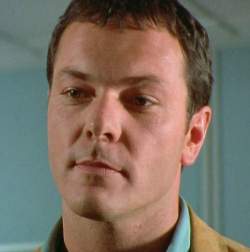
Characters
Jeff Slade is described by his creator Anthony Horowitz as 'a police detective who is not very good at his job'. Although he doesn't seem to be much of an intellectual, he has an obvious native wit and charm. Despite his lack of serious application, he gets away with things because of bursts of inspiration and a maverick approach. He has no scruples about using the time machine to solve crimes the cheat's way. We don't learn much about his private life or history, but we know that his father was a policeman who was wrongly convicted and sent to prison for armed robbery, that he was married but now lives alone, and that he has in his flat a photograph of a girl - identity undisclosed - who is dead. He lives in a kind of loft apartment, virtually bare because he couldn't afford both the flat and furniture to go in it, and he is a knowledgeable, talented cook. Slade is played by Michael French, who until recently was a major character in EastEnders, the UK's highest-rated soap opera.
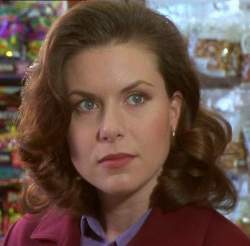 Holly Turner's life is completely dominated by her secret work, to which she is passionately devoted. She works in the police department as a science officer only to fund the machine, which drains all her salary and has sunk her into debt - it also enables her to maintain a distance from any scientist who might guess her secret, though she still participates in the scientific community by giving papers at conferences. She lives in what looks like an expensive flat in a typical central London mansion block, which had belonged to her father, and we know of only one past relationship with an ex-student of her father's. She seems to be lonely, with such an intensely focused life, and it's obvious that letting Slade into her secret has given her the chance to be close to someone - whatever else there might be between them. Holly is played by Chloë Annett, who will be better known in cult TV circles as Kochanski in the seventh series of Red Dwarf.
Holly Turner's life is completely dominated by her secret work, to which she is passionately devoted. She works in the police department as a science officer only to fund the machine, which drains all her salary and has sunk her into debt - it also enables her to maintain a distance from any scientist who might guess her secret, though she still participates in the scientific community by giving papers at conferences. She lives in what looks like an expensive flat in a typical central London mansion block, which had belonged to her father, and we know of only one past relationship with an ex-student of her father's. She seems to be lonely, with such an intensely focused life, and it's obvious that letting Slade into her secret has given her the chance to be close to someone - whatever else there might be between them. Holly is played by Chloë Annett, who will be better known in cult TV circles as Kochanski in the seventh series of Red Dwarf.
Other characters are Chief Inspector Kate Grisham, in charge of the police department, sidekick detectives Morris and Nicky - none of whom know about the time machine, though they start to get suspicious about Slade's suddenly improved clear-up rate - and Danny, the janitor at Holly's flat.
The relationship
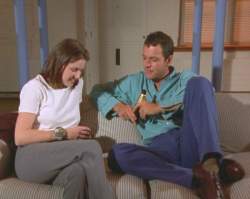
Central to the story, providing its sparkle and impetus, is the relationship between the two protagonists. At first glance this appears to be a standard- issue will-they-won't-they tease, but followed closely it becomes more realistic and interesting than that. The on-screen chemistry between the actors is obvious and has even led to rumours of an real life off-screen romance, but the connection between the characters of Holly and Slade is vital - without it, the story doesn't make sense.
In the first episode, Holly uses the machine to rescue Slade's career and then confesses its existence to him over a cappuccino. Without this disclosure, there would of course be no show. She doesn't even hint at her motives, and the pair don't appear to have been specially friendly before this incident, but we have to assume that Holly had favourable feelings towards him from a distance. As soon as Slade realises that the machine really does work, there is a constant tension between them over its use which reaches blow-out in episode six, Death Minister, when Slade uses the machine without Holly's consent and she throws him out of her flat with a promise never to see him again.
However, the most sexually-charged scene between them occurs in episode three, Fashion Shoot, when Holly is invited back to Slade's flat for the first time. They have travelled back in time a day and a half and have to kill some hours before the murder they want to investigate is due to occur. Holly cannot go back to her own flat because she is already there, asleep - and it is vital that they don't meet themselves across timelines - so they decide to spend the night at Slade's. From an initial polite awkwardness, clearly showing that they are not at this early stage comfortable or familiar with each other's space, they progress over the evening to the kind of tentative closeness that precedes romantic advances between relative strangers. Then Holly suddenly remembers the reason that Slade is not at home that night - she has, wrongly, picked up the idea that he spent the night with the soon-to-be murder victim, a glamorous designer - and she throws her glass of beer into his face. This abrupt over-reaction - "Do you know how cheap that makes me feel?" she cries - definitely contributes to the suggestion in the atmosphere that they might have ended up in the same bed together that night. It also shows that Holly is insecure and on edge, and perhaps inexperienced, in personal encounters.
Curiously, they never seem to get into that kind of situation again. At the end of the same episode, once Slade has reassured her that he did not sleep with the designer, they open a bottle of wine and decide to 'start again'. In subsequent episodes, we see them intimate and relaxed together in an apparently platonic way. After the row in Death Minister, Slade brings her flowers to apologise - the way she looks at him when she opens the door to him, even before she has seen the bouquet hidden behind his back, could hardly be softer or more forgiving - and in the next scene they are draped over the sofa together like an old married couple.
Nonetheless, when an old boyfriend of Holly's turns up in the final episode of the series, Slade reacts with unambiguous jealousy, gate crashing a dinner date and pursuing him as a suspect in the episode's murder case.
Every time the machine is used, some expensive component is liable to burn out. Holly is therefore reluctant for very practical reasons not to use it frivolously, and most episodes are constructed around there being a compelling reason for her to do so nonetheless. Ultimately, however, she seems to have been charmed by Slade into over-using the machine for arguably unscrupulous purposes - in one episode, he even persuades her to try to cheat the laws of time and use it to win the National Lottery.
One possible interpretation of the central relationship is that she is in love with him, and he is aware of the power he has over her and doesn't want to risk it by getting sexually involved. Or - since Slade is not shown to be a calculating character - she is in love with him but is herself wary about getting further involved because of that power and the need to protect her work. Holly's feelings for Slade are clear, his for her not so easy to interpret.
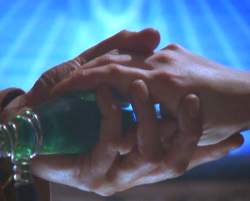
What is certain is that their relationship is a triangle, with the time machine forming the third corner. It comes between them and it binds them together. This is visually emphasised in the final shot of the last episode, The Broken Crystal, when Slade recovers a vital component which had burnt out and which Holly could never have afforded to replace. Before he lets her have the part that will enable the machine to carry on, he pulls it back from her. "What was it we were saying? About you and me?" As he holds the component out to her, their hands interweave over it just before the final credits roll. Before revealing to her that he had the crystal, Slade had been trying to get her to admit that as crime travellers they had been a good team - that was what they had been saying about you and me. But the words and the image are wide open to more than one construction.
Conclusion
Crime Traveller is in the best tradition of British television fantasy. Not innovative, not serious, not even long enough; but well-written, self-consistent and enjoyably performed. And like many shows which leave a lot of questions unanswered, there is plenty of scope for imaginative re-interpretation. Apparently no decision has yet been taken about whether there will be a second series, but I would certainly like to see much more.
Episode Guide
1: Jeff Slade and the Loop of Infinity
Holly reveals the existence of the time machine to Slade, when she uses it to help him keep his job by solving a case for him. Slade challenges her to prove that it really works by taking him back in time to help solve the mystery of the apparent suicide of a businessman.
2: A Death in the Family
Holly's Aunt Mary is murdered in a fashionable restaurant. Slade persuades Holly to use the time machine to find out what really happened. Unfortunately, their presence in the restaurant at the time of the murder is discovered and the circumstantial evidence leads to Holly being arrested. Slade has to race against time to free her from custody before the deadline.
3: Fashion Shoot
A glamorous fashion designer has been receiving death threats and the department is assigned to protect her. When she is shot down on the catwalk at the presentation of her new collection, Slade and Holly go back in time to investigate.
4: The Revenge of the Chronology Protection Hypothesis
While giving a paper at a conference, Holly sees on a television news report that Slade has been shot and critically injured during a hold-up at a jeweller's shop. She goes back in time, desperate to prove her own theory wrong and change the past - and inadvertently precipitates the event herself.
5: Sins of the Father
Slade is framed for a diamond robbery, causing him to re-assess the case of his father, an ex-policeman who was jailed five years before under similar circumstances. Holly lets him use the machine to help clear his name.
6: Death Minister
The machine is breaking down through over-use, and Holly decides that they must stop using it to solve crimes. But when a government minister is murdered, Slade takes matters into his own hands and uses the machine without her consent. He almost becomes trapped in the loop of infinity after losing the neutralising timepiece, and Holly, hurt and furious, tells him that they are finished.
7: The Lottery Experiment
Slade brings Holly flowers to apologise and she forgives him immediately. He has had a new idea - a scheme to use the machine to win the National Lottery, despite the laws of time which make it impossible for the traveller himself to buy a winning ticket. Inevitably, the plan does not go smoothly.
8: The Broken Crystal
A man is run over and killed outside Holly's flat while trying to talk to her. When they try to use the machine to find out what happened, a vital and irreplaceable component burns out. Subsequent events lead Slade and Holly to suspect that there is another time machine in existence, and an old boyfriend of Holly's raises suspicion, and jealousy, in Slade.